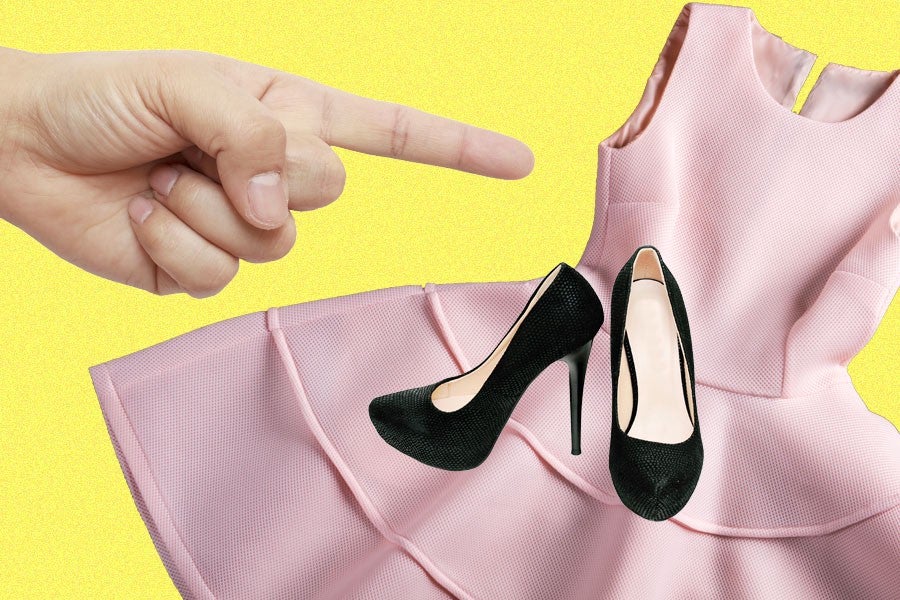In the final episode of the 13th season of Keeping Up With the Kardashians, Kanye West flew to France for 24 hours just so he could style his wife and her sister, Kourtney, in Givenchy. In addition to personal styling appointments, Kanye also sends trend memos to his wife. “[Kanye] sent me a whole email like, ‘You cannot wear big glasses anymore. It’s all about tiny little glasses,’” Kim tells Kourtney and Jonathan Cheban in the episode, referring to those Matrix-like sunglasses from the 1990s that are currently back in vogue.
While this seems to many like the usual couple dynamic being turned on its head — a man dressing his wife instead of vice versa — the concept of men telling women what to wear is hardly a new one. The runways of Paris, New York and London, the vanguard of women’s fashion, display garments almost exclusively from male-run fashion houses. If anything, when you think couture, you think Lagerfeld, Balenciaga, Yves Saint Laurent, Givenchy, McQueen and Versace. You think of the imperious male fashion designer, like the one portrayed by Daniel Day Lewis in Phantom Thread, telling women which dresses makes them look beautiful, and how best to wear them.
So how did we end up in a world where, by and large, women are being dressed by men?
“Telling people what to wear is largely about a hunger for authority,” explains Kimberly Chrisman-Campbell, a fashion historian, who offers several explanations for why more men than women have stitched their initials on a woman’s wardrobe. “The power dynamic is less about fashion than it is about being in a position to authorize someone’s behavior and their aesthetic.”
Other social factors have contributed to this gender disparity in women’s fashion, too. “Some of it has it to do with the fact that men have an easier time getting backing — historically speaking, men have been more financially independent,” explains Chrisman-Campbell. “Social factors have made it much harder for women to run their own businesses.”
The trend of a fashion house run by a male figurehead began in the mid-17th century with Charles Frederick Worth, the father of couture. “He was the first man to make a name for himself as a women’s fashion designer. He became known as an artist who dictated what women should wear,” says Chrisman-Campbell. “Before Worth, it was controversial for men to work in women’s fashion. There were jokes about men dressing women. People got used to it because Worth cultivated upper-class clients.”
As a result, for years, women worked behind the scenes. “They weren’t figureheads or financial heads of fashion houses,” says Chrisman-Campbell. Little has changed since then: As New York Times fashion critic Vanessa Friedman noted in 2015, fewer than 20 percent of the 91 brands on the official Paris Fashion Week schedule had female creative directors. “Where are the women?” Friedman asked. “They’re not just missing from the upper echelons of big fashion houses, but also as successful heads of their own independent labels.”
The last couple of years have seen something of a shift, though. “We’re in another fertile period for women to enter the fashion industry,” says Chrisman-Campbell. “Female creative directors are being appointed at legacy houses like Givenchy, Dior and Lanvin. What many of these designers have in common is a streamlined design aesthetic married to a personal understanding of women’s changing lifestyles.”
There are a few arguments for why such a shift began, although not all of them are the feelgood story of positive social change you might be hoping for. Chrisman-Campbell cites the AIDS crisis as a primary cause: “In the 1980s, investors became reluctant to back male designers during the AIDS crisis, which inadvertently benefited women designers,” she explains.
Another argument tries to explain the change by pointing out that the fashion world is becoming less and less focused on couture, instead putting a greater focus on women who design with “practical” aspects in mind.
So what, then, best explains the relatively recent emergence of more female creative directors at legacy fashion houses? “I think they succeed in times of great social change because they instinctively understand what women want to wear, long before male designers catch up.”
Sorry Kanye. Maybe it’s time you let Kim figure out her own wardrobe.

